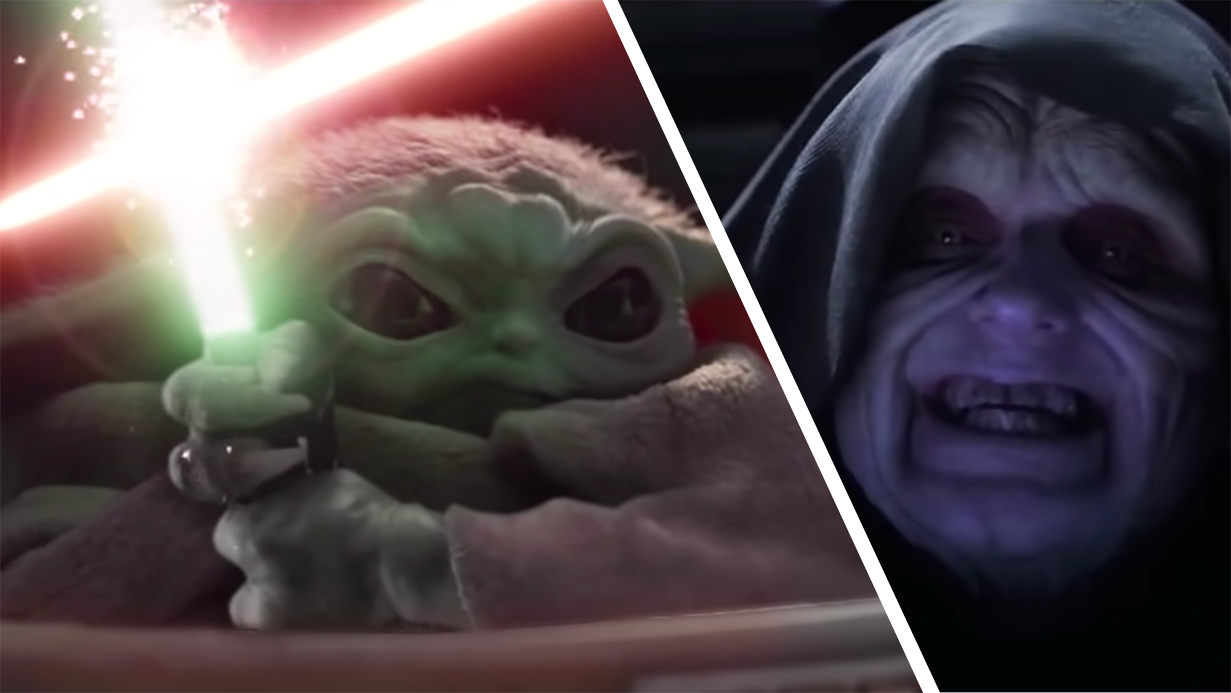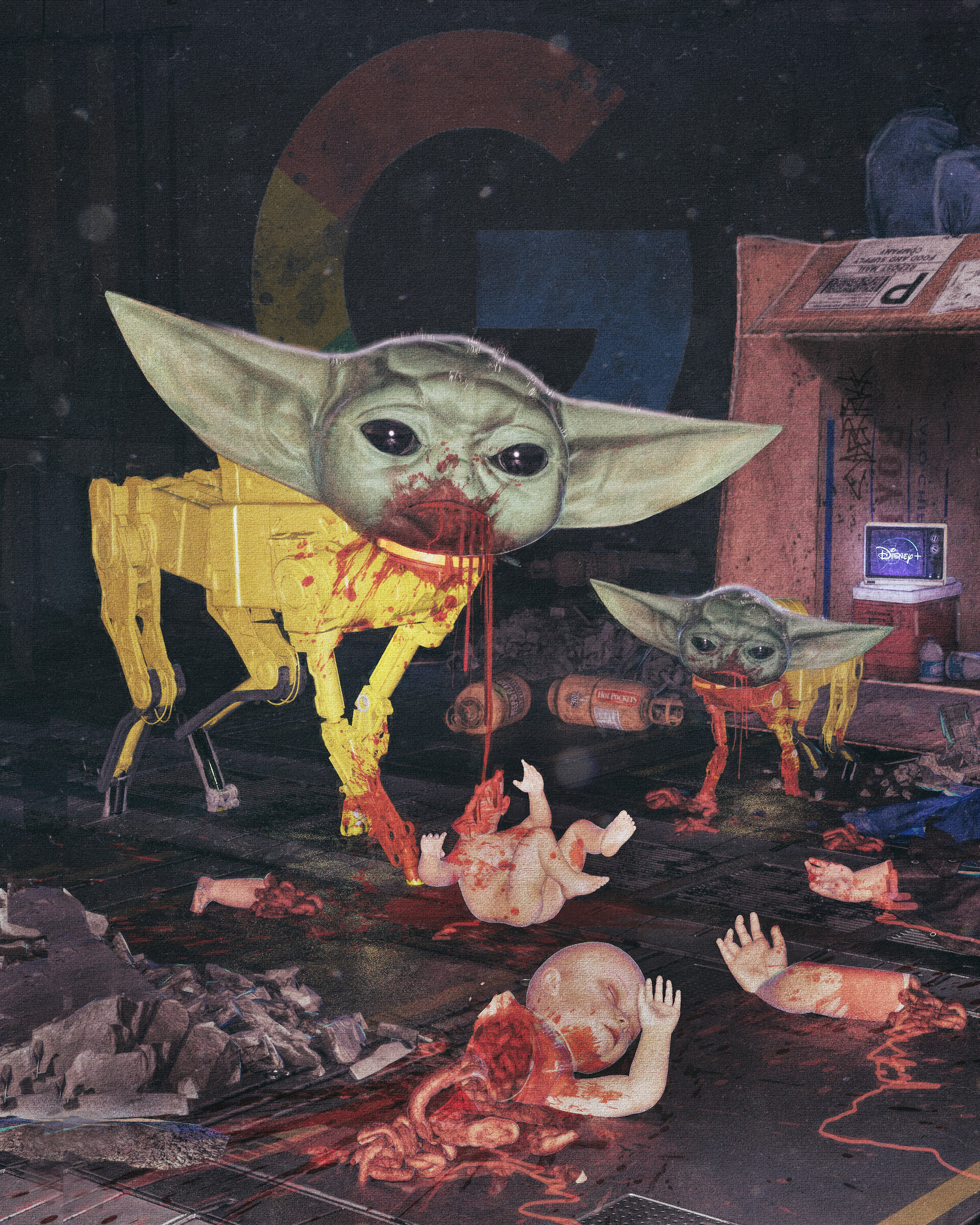I immediately had the feeling in my gut that I was being suckered after being bombarded with online images of the so-called “Baby Yoda” from the new Disney+ streaming service anchor show, The Mandalorian. I am pretty sure I know why (because I had a dog).
The concept of ‘neoteny’ is related to evolutionary physiological adaptations which promote more juvenile features in mature animals. This is an oversimplification, but in a psychological sense, humans seem to like dogs and babies in large part because of this phenomenon. (It is also apparently related to human sexual selection.)
So not to entirely lump Disney in with the likes of Russia and Michael Avenatti for its practice of the dark arts of psychosocial influence – but in a way, I think I can make an argument that despite its cuteness, the Baby Yoda is clearly a marketing ‘active measure’ from the Dark Side to sell Disney+ subscriptions in line with Disney’s MO for character design.

First, lest you suggest I am applying an obscure concept to this argument, it has been well-observed that the character of Mickey Mouse himself has evolved over the years in order to capitalize on neoteny. The paper “A Biological Homage to Mickey Mouse”, by Stephen Jay Gould which originally appeared in the journal ‘Natural History’ in 1979 stated:
“As Mickey’s personality softened, his appearance changed. Many Disney fans are aware of this transformation through time, but few (I suspect) have recognized the coordinating theme behind all the alterations–in fact, I am not sure that the Disney artists themselves explicitly realized what they were doing, since the changes appeared in such a halting and piecemeal fashion. In short, the blander and inoffensive Mickey became progressively more juvenile in appearance. (Since Mickey’s chronological age never altered–like most cartoon characters he stands impervious to the ravages of time–this change in appearance at a constant age is a true evolutionary transformation.
Progressive juvenilization as an evolutionary phenomenon is called neoteny.
…
To give these observations the cachet of quantitative science, I applied my best pair of dial calipers to three stages of the official phylogeny–the thin-nosed, ears forward figure of the early 1930s (stage 1), the latter-day jack of Mickey and the Beanstalk (1947, stage 2), and the modern mouse (stage 3). I measured three signs of Mickey’s creeping juvenility: increasing eye size maximum height) as a percentage of head length (base of the nose to the top of rear ear); increasing head length as a percentage of body length; and increasing cranial vault size measured by rearward displacement of the front ear (base of the nose to top of front ear as a percentage of base of the nose to top of rear ear).
All three percentages increased steadily–eye size from 27 to 42 percent of head length; head length from 42.7 to 48. 1 percent of body length; and nose to front ear from 71.7 to a whopping 95.6 percent of nose to rear ear. For comparison, I measured Mickey’s young “nephew” Morty Mouse. In each case, Mickey has clearly been evolving toward youthful stages of his stock, although he still has a way to go for head length.
You may, indeed, now ask what an at least marginally respectable scientist has been doing with a mouse like that. In part, fiddling around and having fun, of course. (I still prefer Pinocchio to Citizen Kane.) But I do have a serious point–two in fact–to make. We must first ask why Disney chose to change his most famous character so gradually and persistently in the same direction? National symbols are not altered capriciously and market researchers (for the doll industry in particular) have spent a good deal of time and practical effort learning what features appeal to people as cute and friendly. Biologists have spent a great deal of time studying a wide range of animals.
…
In any case, the abstract features of human childhood elicit powerful emotional responses in us, even when they occur in other animals. I submit that Mickey Mouse’s evolutionary road down the course of his own growth in reverse reflects the unconscious discovery of this very biological principle by Disney and his artists. In fact, the emotional status of most Disney characters rests on the same set of Distinctions. To this extent, the magic kingdom trades on a biological illusion–our ability to abstract and our propensity to transfer inappropriately to other animals the fitting responses we make to changing form in the growth of our own bodies.
…
As a second, serious biological comment on Mickey’s odyssey in form, I note that his path to eternal youth repeats, in epitome, our own evolutionary story. For humans are neotenic. We have evolved by retaining to adulthood the originally juvenile features of our ancestors. Our australopithecine forebears, like Mickey in Steamboat Willie, had projecting jaws and low vaulted craniums.”
Conversely, Gould notes that villains in Disney cartoons have features which make them more ‘adult’ in appearance.
Over at ‘The Outline’, Jeremy Gordon has already suggested that Baby Yoda is an emotional overdose which is targeted not to kids but “for their parents, who signed up for the service” and that it is “the product of a merciless capitalist machine bent on one goal: buy our shit. It’s the logical endpoint of a sinister company with decades of experience at tapping deeply into the human need to nurture something small and charming, literally designed in a lab to provoke devotion and love…”
(NEOTENY)
Gordon continues: “Alright, maybe that’s needlessly cynical — after all, isn’t that the ultimate goal of any commercially accessible art? Sure. But the Disney-Marvel-Lucasfilm content machine is historically singular: following its merger with Fox, Disney now commands 35 percent of the film industry’s market. It’s not uncharitable to suggest they’re bent on repressive domination, especially when you consider how their original content has controlled the box office for the last 10 years and counting, and their plans for infinite more Star Wars and Marvel movies. They don’t want you to care about other content; they want you to care about this…
So credit to Disney for mastering the game, for employing a million hyper-competent graphic artists and a million marketing executives who’ve focus-tested Baby Yoda across America to conclude that it will inspire a million viral tweets. And from here, why not keep the baby train rolling as long as possible? Why not Baby Chewbacca? Baby Jawas? Baby C-3PO? Baby Darth Maul? Let us all float on a sea of baby-inspired cultural detritus to prevent us from glimpsing the vast depth below, given Disney’s tireless resources and monastic intent on staying in the news cycle. “
I guess given the core linkage between Disney’s most popular characters and neoteny (and the converse portrayal of villains), it does not seem that it is out of left field to suggest Disney (which owns the Star Wars franchise now) would also capitalize on these same psychological heuristics when designing the marketing machine to not only “sell” The Mandalorian, but the Disney+ streaming service as well.
(I don’t endorse any streaming services, but would recommend you watch South Park season 16 episode 14 and season 23 episode 9 .)
https://www.youtube.com/watch?v=ECcuI8vmc-g
To be clear, I am not opposed to big corporations who have to sell their products in order to be profitable and remain in business – but I am opposed to people who try and “hack” my mind – whether that be Russia or Michael Avenatti or apparently Disney. I don’t think Disney is an evil company per se, I just think this is a useful example of something which is very similar to online conspiracy theories, memes, active measures (eg. creating something which isn’t real and making it “real”), etc.
However, it is clear whatever algorithms and focus groups have drummed up from our subconscious, it is not always a good thing – even if we may feel like it. More often than not, it is a way to control us – in this case, apparently to get us to subscribe to Disney+ subscriptions – or to poison the well until parents give in to their kids’ incessant demands for Disney+.
It doesn’t seem controversial to me to say Baby Yoda is likely the brainchild of a marketing team of Sith Lords designed to fleece you of your money. Who knows what else they will sell you once they get their hooks in you. Don’t give in to the Dark Side of the marketing force.
Hmm… Baby Yoda-faced terminators? That might be a good way to thin the herd?

